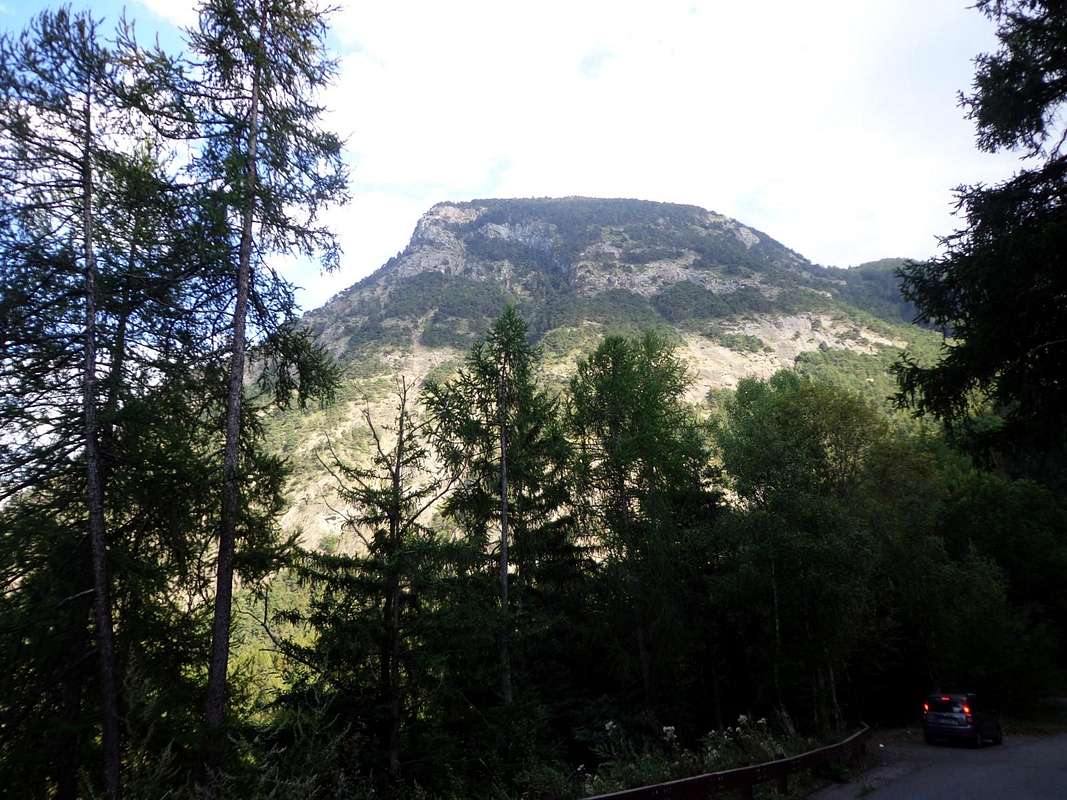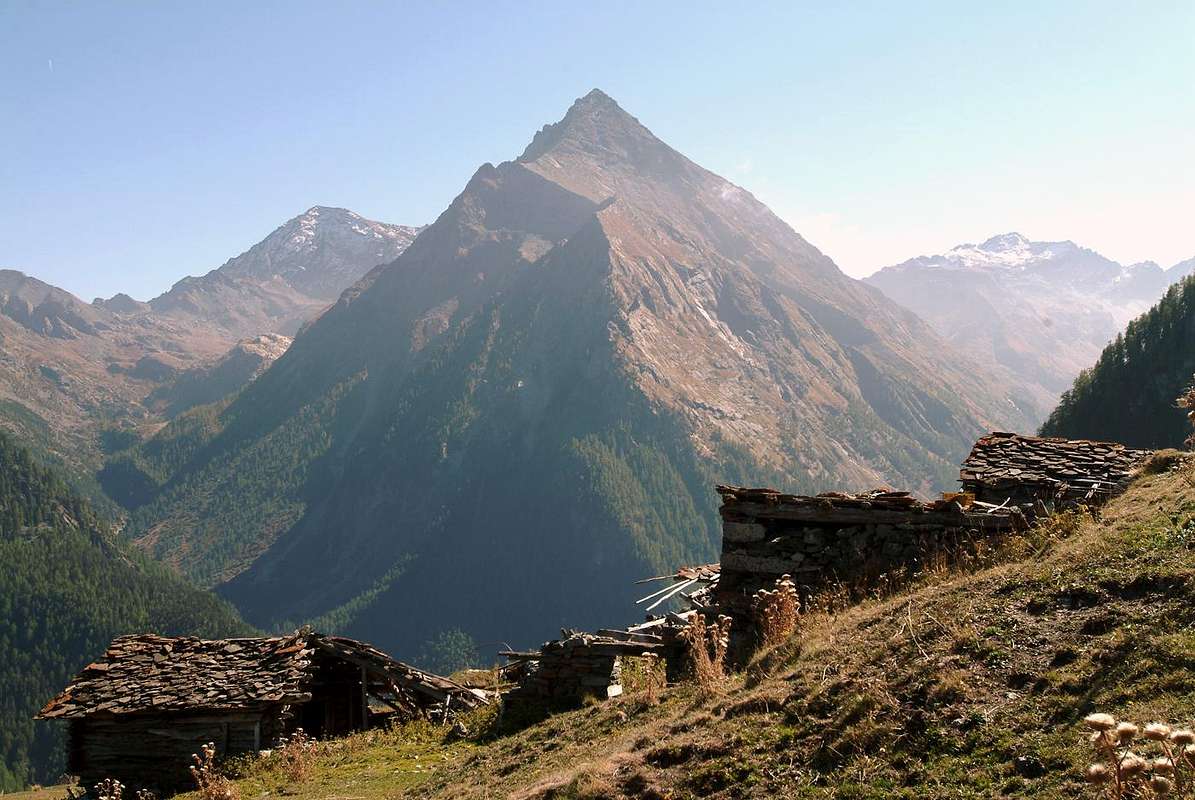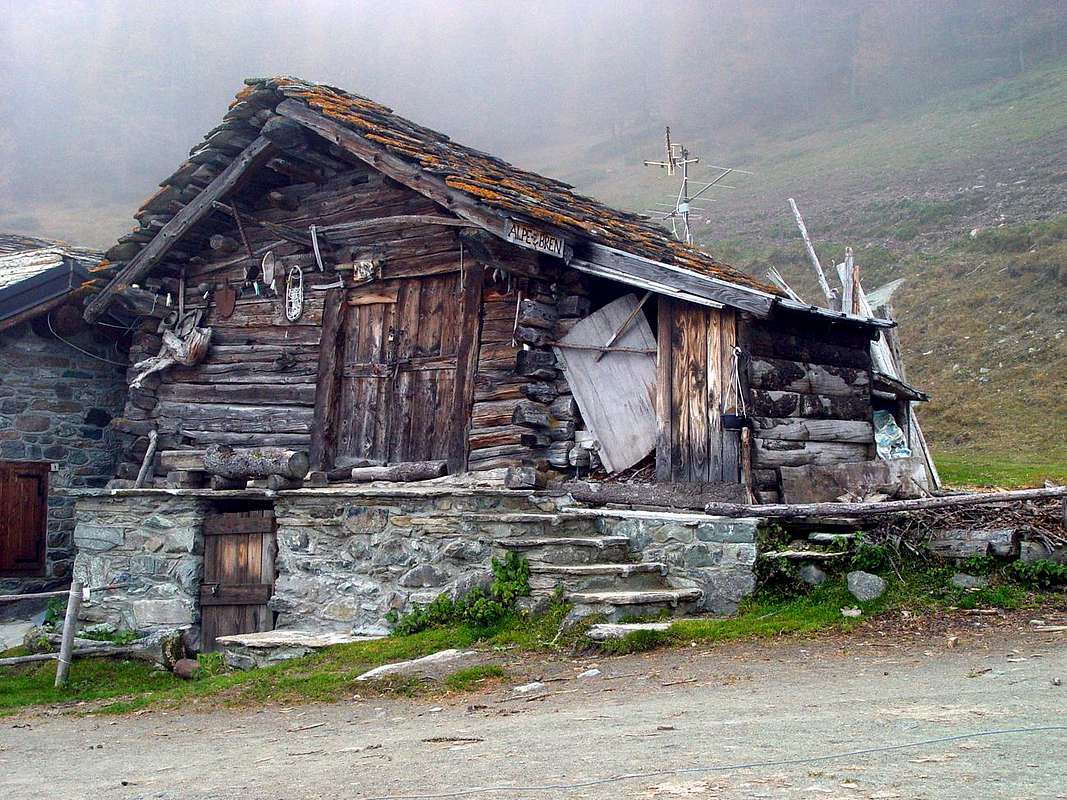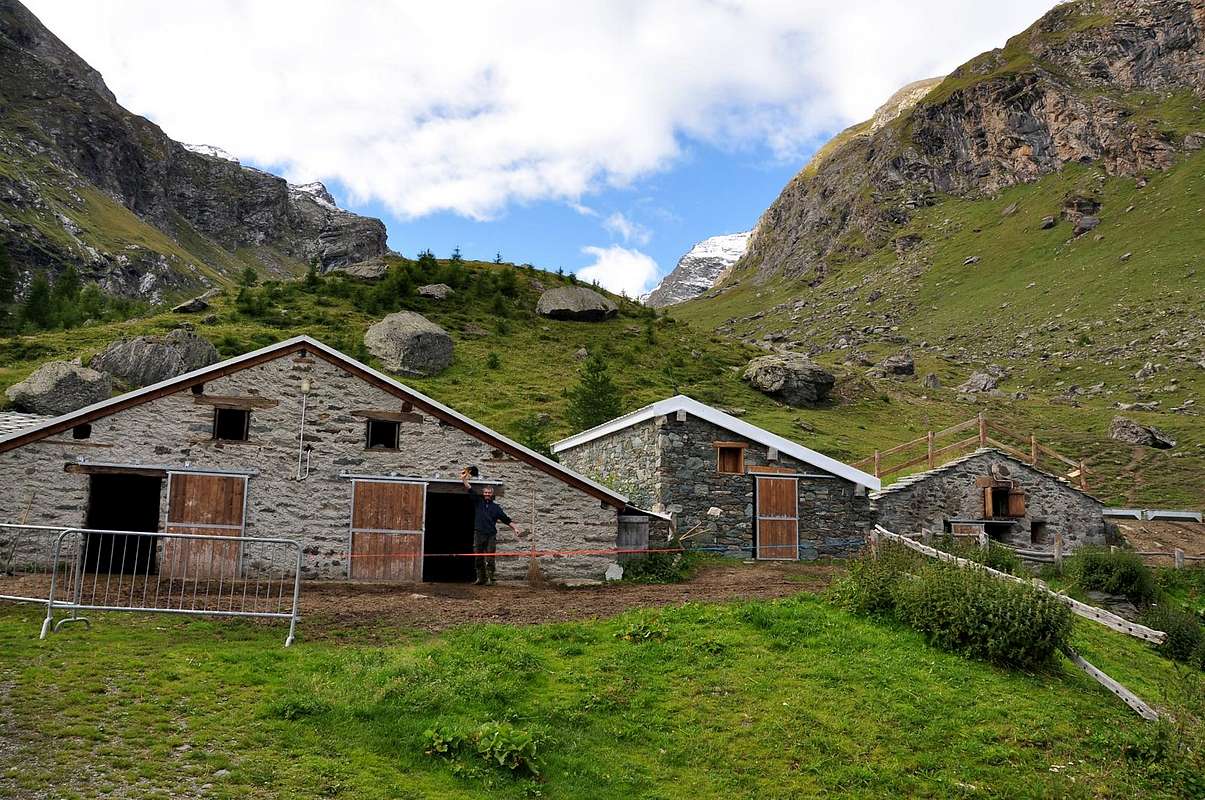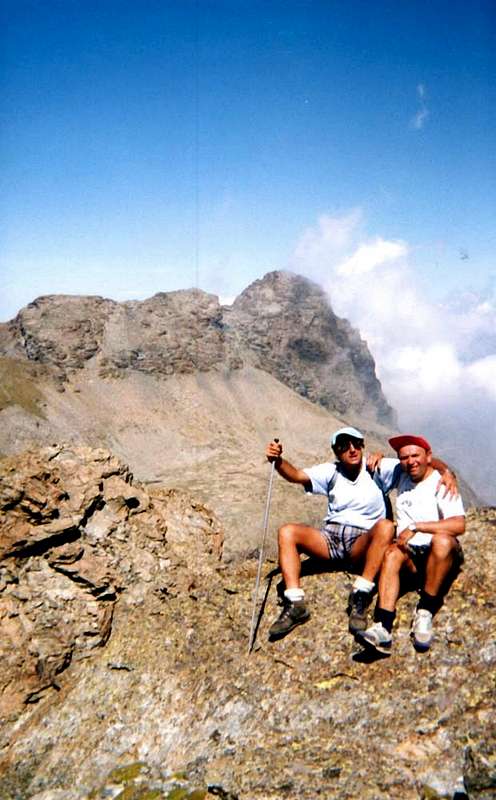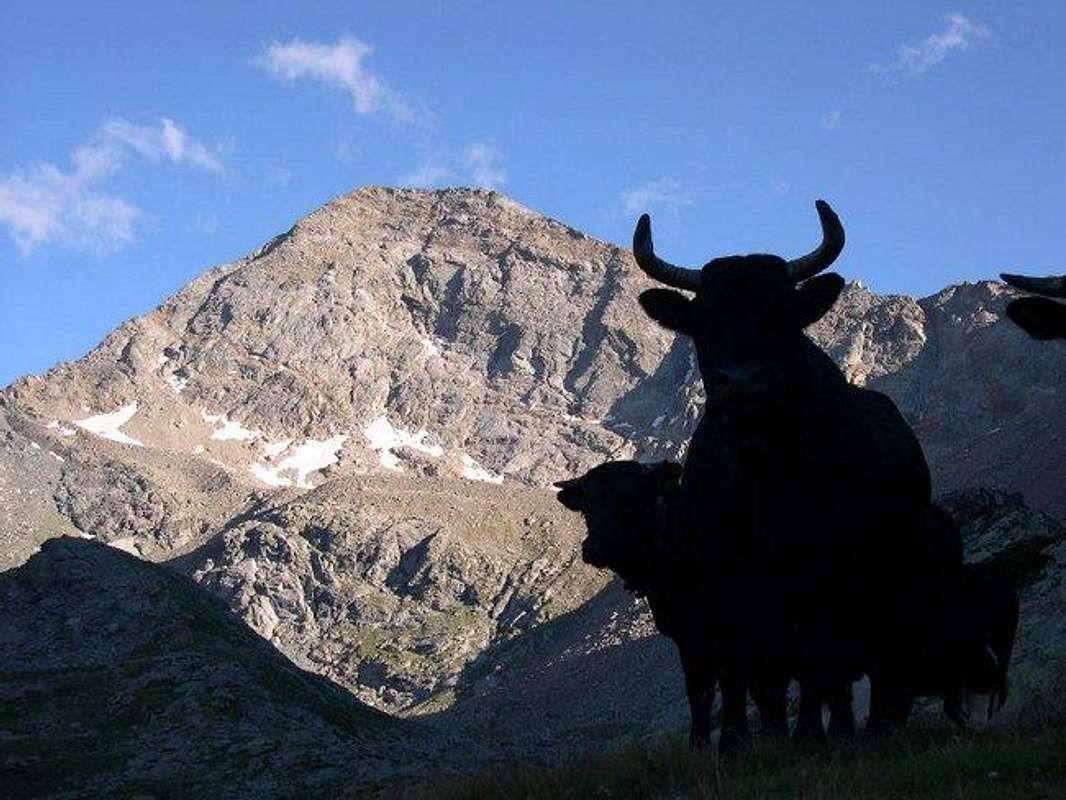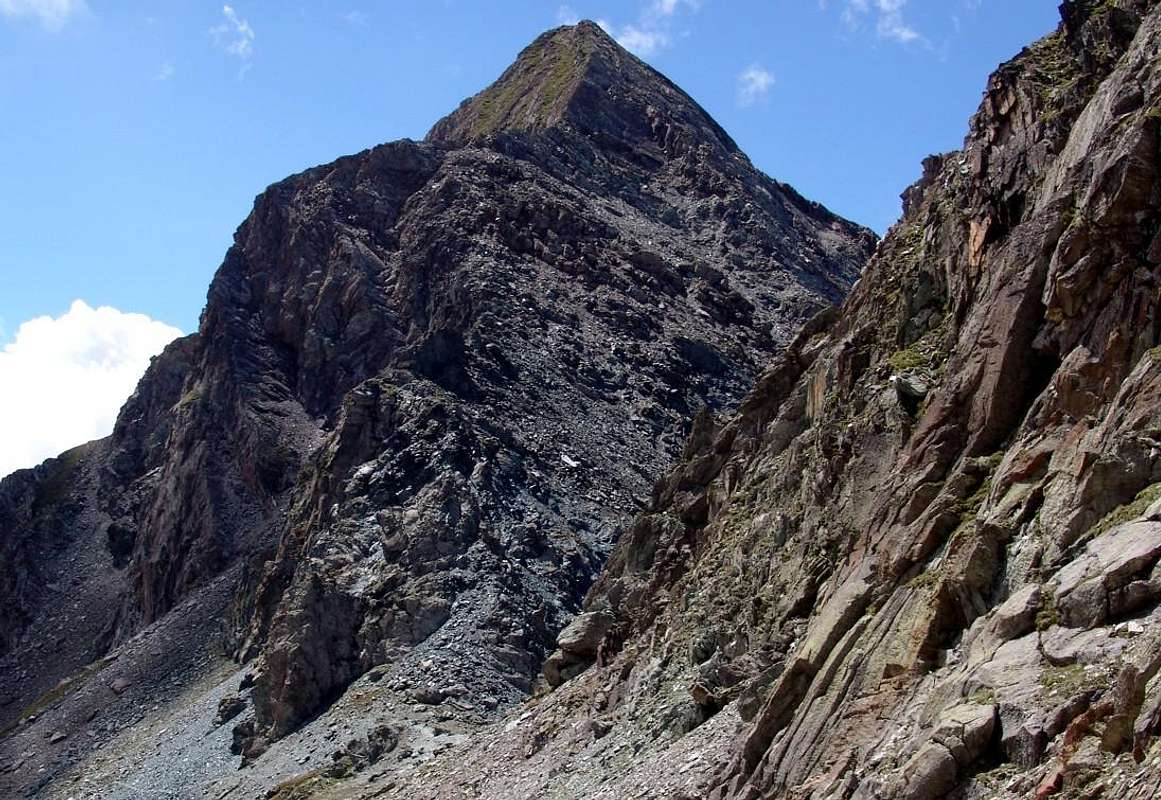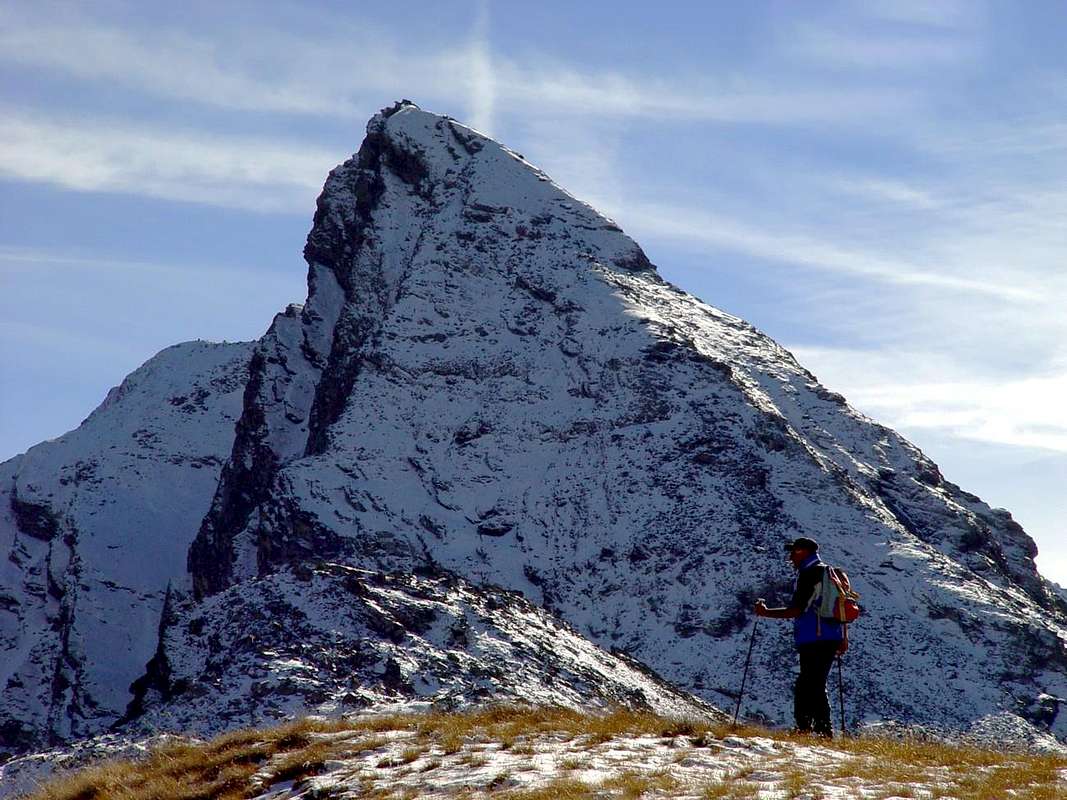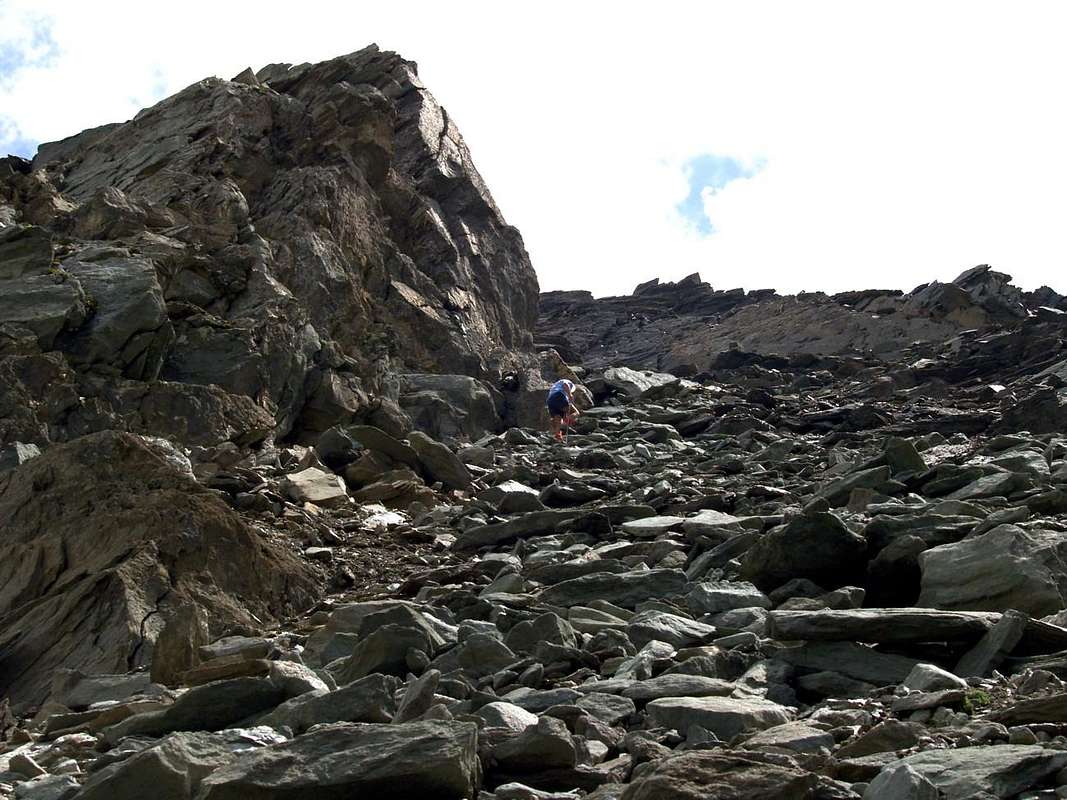-
 2942 Hits
2942 Hits
-
 79.04% Score
79.04% Score
-
 10 Votes
10 Votes
|
|
Route |
|---|---|
|
|
45.73392°N / 7.49893°E |
|
|
Spring, Summer, Fall, Winter |
|
|
A long day |
|
|
Various |
|
|
Note
|
La montagna chiama i suoi figli, ed essi rispondono fedelmente al suo appello… Osvaldo Cardellina, Diario alpinistico, 1964-65 Page texts: @ OsvaldoCardellina "Osva", passed away on May 2, 2022. Page owners: Christian Cardellina e Osvaldo Cardellina. Any updates from September 12, 2022: Antonio Giani, page administrator, friend and climbing companion. Testi della pagina: @ OsvaldoCardellina "Osva", scomparso il 2 maggio 2022. Proprietari pagina: Christian Cardellina e Osvaldo Cardellina. Eventuali aggiornamenti dal 12 settembre 2022: Antonio Giani, amministratore della pagina, amico e compagno di salite. |
Hiking & Mountaineering Goldenroads Overview
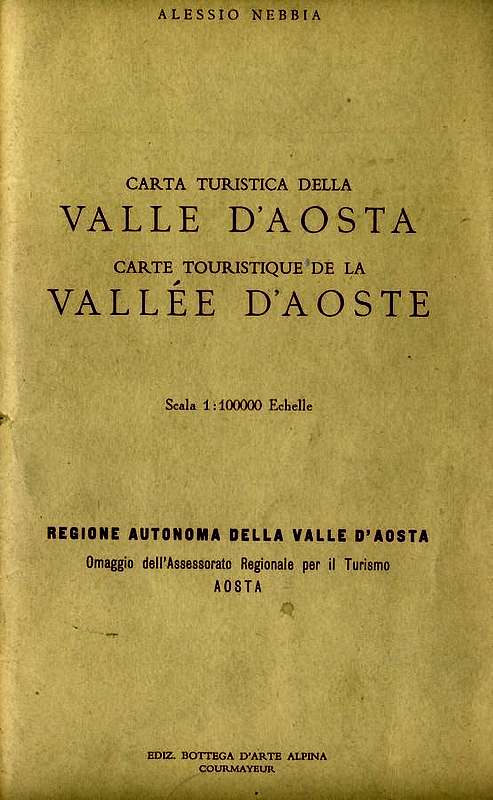
The Val Fénis is a small Valley in the size of the entire Alpine Arch, but is large enough compared to the tiny Valley of Aosta. It is specially wanted to separate this work, more directed to the itineraries, from those just made in My Areas with "Four walloons to make a valley: Fénis-Clavalité/High Comba Tersiva/Savoney/Lavodilec", in order not to complicate the first and instead giving space to the second in which they propose ten trips designed to make known in its entirety this long valley over 15 Kilometers from Fénis Common up to the Hills of Medzove, Fussì or Fussy and Fénis. Rather it is given more space to Approaches than to the Routes, described here in more than synthetic almost telegraphic, remaining the same, in our opinion, a simple guideline, stops the possibility of other personal choices and maybe completely different or diversified. As regards the former, however, is given a complete and comprehensive writing with the aim of power easily "break into" in this valley or an excursion where you should "lean", albeit marginally, to the next Saint Marcel Common with which, in addition to being adjacent, is definitely connected. This into consideration especially for trips to Mont Saint Julien with his renowned Sanctuary, territorially belonging to the Fénis Municipality and Mount Corquet, although the way described here takes place entirely in this valley, from Clavalité through the Tramouail de la Rossa. Nothing prevents you from doing the excursion on the opposite side through what is considered the "Trad Via", taking advantage of a paved road connecting that Fènis, through the small Pieiller Walloon, connects to that, coming from St. Marcel, goes to the little Villages of Les Druges Low and High, where the valley splits, sending a sub-branch in Southeast towards the Alps of Fontanafredda, Bren, Prapremier and Corquet and towards Mont Corquet, while the main, after rounding the Mont Roux with its Coppermines Chuc-Servette, more salt Westwards the real Walloon St. Marcel and the Hunting Reserve Marquis Attilio Turati.
![]()
Val Fènis-Clavalité with Col Fussì between Glacier & Delà from Northwest, by Antonio
Certainly this is not a valley which presents great opportunities for extreme climbing and even, Punta Tersiva aside, reaching average heights very high. All, or nearly so, the tours have bid more directed to Hikers than to the Mountaineers. Also the quality of the rock is never good and, being very old mountains and somewhat transformed from weather very often encountered, as well as very broken rocks, slopes exposed to the risk of small landslides. A pitch easy, but also delicate and requires some experience and also attention; very often in fact are found traits grassy-detrital over rocks and requiring prudence and ability to know the way or simply identify the single "mauvais pas". This is certainly not, as incidentally the nearby Valleys or Vallons of Champdepraz, Ponton, Saint Marcel, Laures, Arpisson, Arbole and the entire Champorcher Valley, the valley of the "kingdom of granite" or even solid rock. These mountains, beautiful to see and to photograph, resemble very nice and old Lord that more and more approaches highlight their difficulties in comparison with the passage of time; almost better enjoy them from a certain distance, if not by far! Even this valley owns many, perhaps even most: beautiful and slender give an idea of wanting to compete with the most famous Summits and Spiers; but then, approaching them, they come out all the possible flaws that go even beyond the imagination. Ancient valley with "daughters" old, that time mercilessly has certainly spared. Fall so the trappings and the imagination desires, while remaining beautiful lakes to testify to the glory of a time long since passed. As well as to the glaciers, except the tiny Glacier Tersiva, now completely disappeared. However, has a multitude of places where you can launch a beautiful challenge even "Her Majesty Tersiva", not free, she too, as many wrinkles that furrow the skin ...
![]()
Val Fènis with Glacier, Rafray & Corquet from Northwest, by emilius
![]()
High Comba Tersiva with Mont Rafray & Tour Moussaillon from Northwest, by M G S


La Val Fénis é piccola nella grandezza dell'intero arco alpino, ma abbastanza grande rispetto alla minuscola Valle di Aosta. S'é voluto appositamente disgiungere questo lavoro, più rivolto agli itinerari, da quello testé effettuato in My Areas con "Four vallons to make a valley: Fénis-Clavalité/High Comba Tersiva/Savoney/Lavodilec", onde non appesantire il primo e dando invece maggior spazio al secondo nel quale si propongono dieci gite atte a fare conoscere nella sua completezza questa lunga valle di oltre 15 Kilometri, da Fénis fino ai Colli di Medzove, Fussì o Fussy e di Fénis. Anzi si é data più importanza agli Avvicinamenti che non alle Vie, qui descritte in modo più che sintetico quasi telegrafico, rimanendo le medesime, a nostro avviso, una semplice indicazione di massima, ferma la possibilità di effettuare altre scelte personali e magari completamente diverse o diversificate. Per quanto concerne i primi, invece, s'é data una stesura completa ed esauriente con il fine di potere agevolmente "introdursi" in questa valle o di effettuare una escursione dove conviene "appoggiarsi", anche se marginalmente, a quella adiacente di Saint Marcel con la quale, oltre ad essere confinante, risulta decisamente connessa. Questo in considerazione particolare per le gite al Mont Saint Julien con il suo famoso Santuario, territorialmente appartenenti al Comune di Fénis, nonché al Mont Corquet, anche se la via qui descritta si svolge completamente in questa vallata, passando dalla Clavalité per il Tramouail de la Rossa. Nulla vieta d'effettuare l'escursione sull'opposto tramite la considerata "Via Tradizionale", approfittando anche di una strada asfaltata di collegamento che da Fènis, tramite il Valloncello del Pieiller, si collega a quella che, arrivando dal Comune St. Marcel, si dirige verso i piccoli Villaggi di les Druges Basse ed Alte, ove la valle si sdoppia inviando un ramo secondario a Sudest verso le Alpi di Fontanafredda, Bren, Prapremier e Corquet nonché in direzione del Mont Corquet medesimo, mentre il principale, dopo aver doppiato il Mont Roux con le sue Miniere di rame di Chuc-Servette, sale più ad Occidente verso il Vallone vero e proprio di Saint Marcel colla Riserva di Caccia del Marchese Attilio Turati.
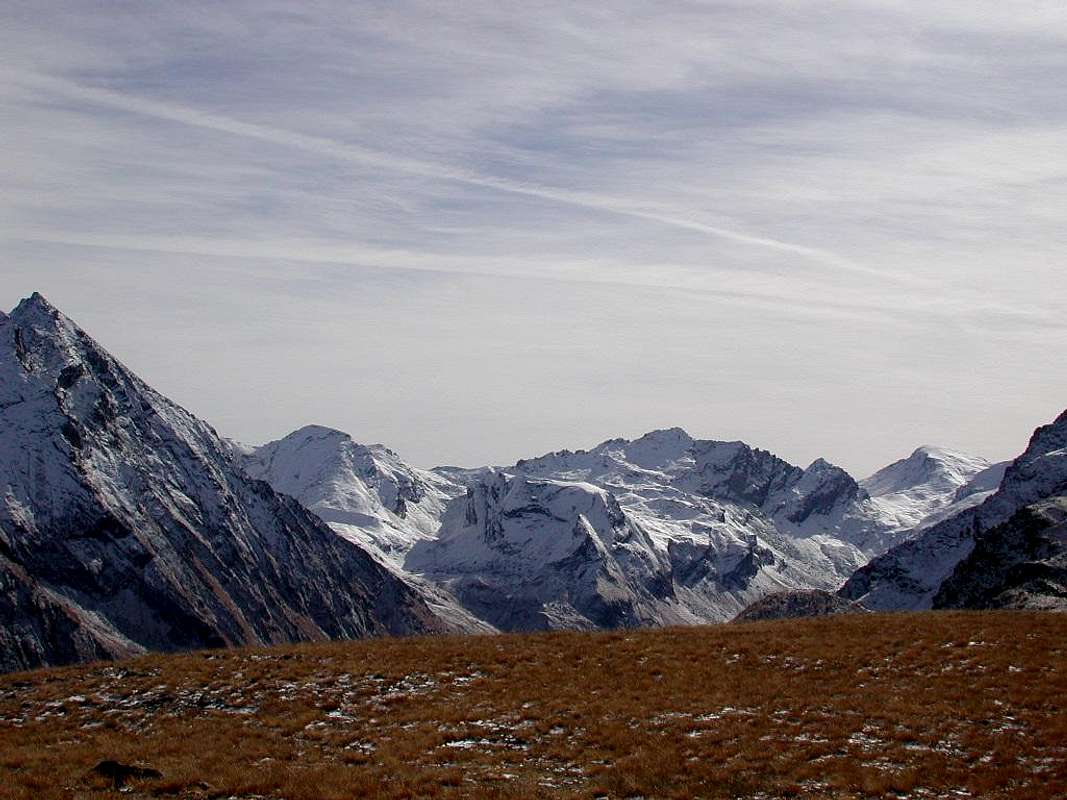
Certamente non é questa valle che presenta grandi possibilità di arrampicate estreme neppur, Tersiva a parte, di raggiunger mediamente altezze elevate. Tutte, o quasi, le escursioni presentano un'offerta più rivolta agli Escursionisti che non agli Alpinisti. Inoltre la qualità della roccia non é mai buona ed, essendo montagne molto antiche ed alquanto trasformate dagli agenti atmosferici molto spesso s'incontrano, oltre che rocce molto rotte, pendii esposti al rischio di piccole frane. Un terreno di gioco facile, ma anche delicato e richiedente una certa esperienza ed attenzione; molto spesso infatti si riscontrano tratti erboso-detritici sopra le rocce e tali da richieder prudenza e capacità di sapere individuare la via o semplicemente il singolo "mauvais pas". Non é certamente questa, come daltronde le vicine Valli o Valloni di Champdepraz, Ponton, Saint Marcel, Laures, Arpisson ed Arbole nonché l'intera Valle di Champorcher, la valle del "regno del granito" od anche della roccia compatta. Queste montagne, belle da vedersi e da fotografare, somiglian molto a delle belle ed anziane Signore che più l'avvicini e più evidenziano lor difficoltà nel confronto col tempo che passa; quasi meglio l'ammirar loro da una certa distanza, se non da lontano! Anche questa valle ne possiede molte, anzi forse quasi tutte: belle e slanciate dan l'idea di volere competere con Sommità e Guglie più famose; ma poi, avvicinandole, escon tutti i difetti possibili, sin oltre l'immaginazione. Valle antica con "figlie" vecchie, che il tempo impietosamente non ha di certo risparmiato. Cadon così orpelli e desideri dell'immaginazione, mentre rimangono splendidi laghi a testimoniare d'una gloria di tempi da lungo tempo trascorsi ed irrecuperabili. Tuttavia, possiede molteplici località ov'è possibile lanciar na bella sfida anche a "Sua Maestà La Tersiva", non esente, pur lei, dalle profonde rughe che le solcan la pelle ...
![]()
"Admiring the pyramid of Punta Tersiva (3.515m) above the Mont La Touriasse (1.895m) from North", by Antonio
BY PLANE:
From the dirt road towards Lovignana Alpage (1.169m) up to the Clavalité Tableland by Fènis Common, by emilius
With departure from Fénis:
by the Municipality follow the rectangular signs (brown with indication Barche; 607m) to the Barche Fraction at the entrance on Val Fénis/Clavalité/High Comba Tersiva. The ban is to continue Lovignana small Village (1.169m) along the entire Clavalité Vallon to Pasture Grande-Alpe (2.129m), through the local path n° 2, pratically almost concomitant with the private farm dirt road in soil, except for brief shortcut after Celey Dèsott Pasture (1.556m; E/F; 4h'00/4h'30 from Barche upper Fraction; 5h'00/6h'00 Lovignana).
Con partenza da Fénis:
dal Comune seguire i cartelli rettangolari (color marrone con indicazione Barche; 607 m) per la Valle di Fénis/Clavalité/Alta Comba Tersiva. Il divieto di proseguire si trova al Villaggetto di Lovignana (1.169 m); percorrere tutto il Vallone fino all'Alpe Grand'Alpe (2.129 m), tramite il sentiero locale n° 2, praticamente quasi completamente concomitante con la strada poderale privata in terra, tranne qualche breve scorciatoia subito appresso Celey Dèsott (E/F; 4h'00/4h'30 dalla Frazione di Barche; 5h'00/6h'00 dal divieto).
Municipal Road in Pieiller vallon to crossroads of Le Coteau, y Osw
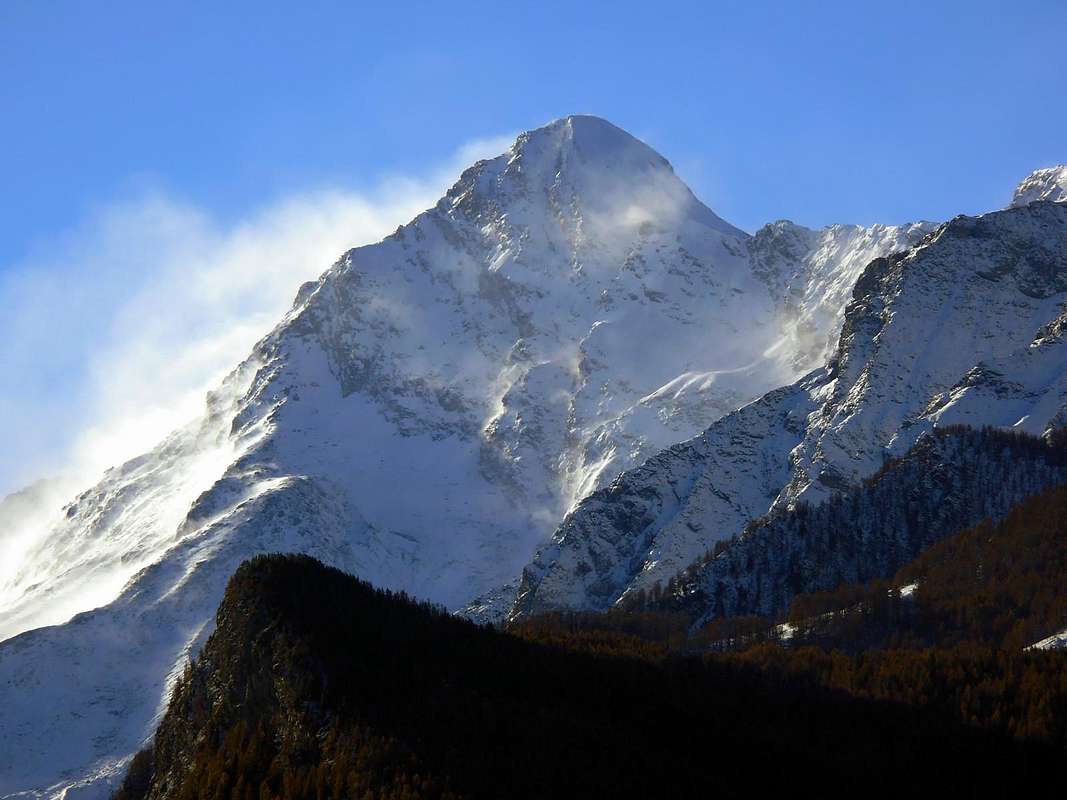
Getting There
BY CAR:- From TORINO, MILANO, etc: Motorway A5. Exit at IVREA or Quincinetto (PIEDMONT).
- From IVREA Town: in West (Southern side) to Pont Saint Martin, Donnas, Bard, Champdepraz, Pontey, Fénis, Saint Marcel.
![]()
Pieiller Vallon secondary to the Fénis-Clavalité-C. Tersiva, by Osw
From Fénis (537m) to Clavalité-Grand'Alpe Pastures (2.129m; through dirt road), just below E. Borroz/Rotary-Clavalité Refuge (2.156m) at Cuneux Alp.
From Saint Marcel (630m) to Saint Marcel Vallon and Turati Reserve up to the Mulac & Grande Chaux Hunting Houses & Alp (1.937m, 2.370m).![]()
Fénis & Saint Marcel Valleys above Dora Baltea from North, by Gangolf Haub
Specific Road
By SS.26, 15 Km by Aosta Town, crossing the stonebridge over the Dora Baltea, just after the Country of Nus (output Motorways A5), arriving at the junction 539 meters, and immediately after the field of Football, leave the roundabout to the left on the same (various large signals), and go up to the Chief Lieu. - From FRANCE: through the Mont Blanc Tunnel to Entrèves-crossroads to Vény/Ferret Valleys - Mountain Guides of Courmayeur - La Saxe Rock Gym - Courmayeur. By Little Saint Bernard Pass, closed since November until half May to La Thuile Valley - Pré Saint Didier - Courmayeur.It is not necessary to take Motorway A5: you can drive on SS.26, in the direction of AOSTA - IVREA - TURIN.
BY PLANE:
- Aeroporto "Corrado Gex" Saint Christophe (Aosta).
Basic Approach for almost all Excursions with Variants towards St. Marcel
With departure from Fénis:
by the Municipality follow the rectangular signs (brown with indication Barche; 607m) to the Barche Fraction at the entrance on Val Fénis/Clavalité/High Comba Tersiva. The ban is to continue Lovignana small Village (1.169m) along the entire Clavalité Vallon to Pasture Grande-Alpe (2.129m), through the local path n° 2, pratically almost concomitant with the private farm dirt road in soil, except for brief shortcut after Celey Dèsott Pasture (1.556m; E/F; 4h'00/4h'30 from Barche upper Fraction; 5h'00/6h'00 Lovignana).
Con partenza da Fénis:
dal Comune seguire i cartelli rettangolari (color marrone con indicazione Barche; 607 m) per la Valle di Fénis/Clavalité/Alta Comba Tersiva. Il divieto di proseguire si trova al Villaggetto di Lovignana (1.169 m); percorrere tutto il Vallone fino all'Alpe Grand'Alpe (2.129 m), tramite il sentiero locale n° 2, praticamente quasi completamente concomitante con la strada poderale privata in terra, tranne qualche breve scorciatoia subito appresso Celey Dèsott (E/F; 4h'00/4h'30 dalla Frazione di Barche; 5h'00/6h'00 dal divieto).
From the Village of Fénis, accessible from Highway n° 26 crossing the bridge over the Dora Baltea Stream, just after the Country of Nus (output Motorways A5), arriving at the junction 539 meters, and immediately after the field of Football, leave the roundabout to the left on the same (large signals), and go up to the Chief Lieu. Following the signs in color marron "Saint Julien" and, still leaving the Municipal Road to the East to Barche Hamlet and towards Clavalité's Walloon satisfy the signs for the "Vallon of Pieiller", a tarmac road dates back to the South, starting between the Villages of Le Perron (582m) and Pommier (614m), and through road bends that door, through the woods, to the small Village of Le Boit-du Chat (695m) and the subsequent of Champlan. After four more through the windings road nearby the Torrent Bioley and goes West towards the basin left its course, always with tight bends reaches The Pieiller-de-Sermaz (1.075m) and then Maison Longue (1.112m) and The Plany (1.174m) small Villages, with a last bend to the West toward the Morgettaz tiny Hamlet reach the junction, with small parking lot on the floor, for the little semi-abandoned Village of Le Coteau (1.234m).
Various Remarks
Prapremier (2.011m), between Fénis/St. Marcel Commons, by Emilio Bertona aka emilius
The carriage, which then continues over and again crosses the Bioley Torrent reaching the other side, with a wide circle first and then North-northwest to West-southwest, reach a junction just beyond the Village Champremier (1.383m), connecting to the Main Road leading up to St. Marcel towards wide Druges Conch thus combining the "viability" in the upper area between these two communes. Please note that the path is formed by a narrow road with many windings, for which reason it is good thing to pay caution.
This Road Connection also allows power to vary the same trip, and after the climb to Saint Julien, such as going to Area Pic Nic Les Druges with the Various Opportunities:
a) - : Stay with the same modest sum payment (large parking in compress earth, various fountains near the "islets" with benches and tables in wood, stone barbecue, toilets);
b) - : visit the Sites of the Mines of Copper and Iron by Chuc-Servette (from the nearby location of Furnace, now in ruins, the tops of which are accessed through marked trails and a General Map departure (Various Coppermines entrances, Houses and the remains of the Miners of large Ropeways wood for the transport of Ore to the valley floor);
c) - : from Les Druges Alte (High or Upper) (1.567m) ascending with the route n° 14 starting at the fountain with adjoining gorgeous little wooden and squared "Rascard" and lift the nearby Chapel of Saint Bernard, from this, depending on your choice , you can continue up to the summer Pastures of Fontanafredda or Fontanafreida (around 1.800 meters), Bren (1.961 m; fountain) and finally the last of Prapremier or Praz-Premier ((2.010m; semi ruined and abandoned), right on the border with Fénis Municipality.
Regarding the descent, in case of extension of the excursion to the Area of Druges, it is convenient from the junction of the road on the right Champremier abandon climbed and get off at Saint Marcel through the Regional Road, in such a way passing from the "Locanda del Diavolo or Inn of the Devil", Viplana, Ronc, Sazailland and Seissogne small Hamlets (1.066m; beautiful wooden mill) you will reach the Village Plout with its very famous Sanctuary of 1640, but existing as a niche, since 1200, dedicated to "Notre Dame des Hermites" (968m; beautiful "Via Crucis" outside on the arcade, which depicts the "Fifteen Mysteries of the Rosary" by a Painter of Asti in 1854). From Plout also Plou continue to Réan, Mezéin (793 m, 300 m before, turn right for Fénis, but with ban), Jayer, Moulin small Hamlets towards St. Marcel (Ancient Castle Location Paquier Fraction; 609m), and finally, passing under the Motorway and crossing the bridge over the Baltea near the ancient Foundry Copper (547m) you get to Highway n° 26.
Combining it with the ascent of M. Saint Julien with St. Grat Shrine and Hermitage from Fénis through Pieiller Walloon, is Fantastic Hiking Tour, scenic, cultural and instructive.
The "Exotic" Alpage of Bren (1.961m) below Mont Corquet, by emilius
Various Remarks
The carriage, which then continues over and again crosses the Bioley Torrent reaching the other side, with a wide circle first and then North-northwest to West-southwest, reach a junction just beyond the Village Champremier (1.383m), connecting to the Main Road leading up to St. Marcel towards wide Druges Conch thus combining the "viability" in the upper area between these two communes. Please note that the path is formed by a narrow road with many windings, for which reason it is good thing to pay caution.
This Road Connection also allows power to vary the same trip, and after the climb to Saint Julien, such as going to Area Pic Nic Les Druges with the Various Opportunities:
a) - : Stay with the same modest sum payment (large parking in compress earth, various fountains near the "islets" with benches and tables in wood, stone barbecue, toilets);
b) - : visit the Sites of the Mines of Copper and Iron by Chuc-Servette (from the nearby location of Furnace, now in ruins, the tops of which are accessed through marked trails and a General Map departure (Various Coppermines entrances, Houses and the remains of the Miners of large Ropeways wood for the transport of Ore to the valley floor);
c) - : from Les Druges Alte (High or Upper) (1.567m) ascending with the route n° 14 starting at the fountain with adjoining gorgeous little wooden and squared "Rascard" and lift the nearby Chapel of Saint Bernard, from this, depending on your choice , you can continue up to the summer Pastures of Fontanafredda or Fontanafreida (around 1.800 meters), Bren (1.961 m; fountain) and finally the last of Prapremier or Praz-Premier ((2.010m; semi ruined and abandoned), right on the border with Fénis Municipality.
Regarding the descent, in case of extension of the excursion to the Area of Druges, it is convenient from the junction of the road on the right Champremier abandon climbed and get off at Saint Marcel through the Regional Road, in such a way passing from the "Locanda del Diavolo or Inn of the Devil", Viplana, Ronc, Sazailland and Seissogne small Hamlets (1.066m; beautiful wooden mill) you will reach the Village Plout with its very famous Sanctuary of 1640, but existing as a niche, since 1200, dedicated to "Notre Dame des Hermites" (968m; beautiful "Via Crucis" outside on the arcade, which depicts the "Fifteen Mysteries of the Rosary" by a Painter of Asti in 1854). From Plout also Plou continue to Réan, Mezéin (793 m, 300 m before, turn right for Fénis, but with ban), Jayer, Moulin small Hamlets towards St. Marcel (Ancient Castle Location Paquier Fraction; 609m), and finally, passing under the Motorway and crossing the bridge over the Baltea near the ancient Foundry Copper (547m) you get to Highway n° 26.
Combining it with the ascent of M. Saint Julien with St. Grat Shrine and Hermitage from Fénis through Pieiller Walloon, is Fantastic Hiking Tour, scenic, cultural and instructive.
Dal Paese di Fénis, raggiungibile dalla SS.26 attraversando il ponte in pietra sulla Dora Baltea, subito dopo il Paese di Nus (uscita Autostrada A5), arrivando al bivio 539 metri; subito dopo il campo di Calcio, lasciare a sinistra la rotonda sulla medesima (ampie segnalazioni), e salire verso il Capoluogo. Seguendo i cartelli in color marron "Saint Julien" e, lasciando ancora ad Est la strada Comunale per la Frazione Barche e la Clavalité, assecondare le indicazioni per il "Vallone del Pieiller"; una strada in asfalto risale verso Mezzogiorno, partendo tra le Frazioni di Le Perron (582 m) e Pommier (614 m), e tramite stretti tornanti si porta, in mezzo al bosco, al piccolo Villaggio di Le-Boit du Chat (695 m) ed al successivo di Champlan. Dopo altri quattro tornanti attraversa il Torrent Bioley e si porta ad Ovest verso il suo corso idrografico sinistro; sempre con stretti tornanti raggiunge il Villaggetto di Le Pieiller-de-Sermaz (1.075 m) e successivamente quelli di Maison Longue (1.112 m) e Le Plany (1.174 m). Tramite un ultimo tornante ad Ovest verso il piccolo Villaggio della Morgettaz raggiunge il bivio, con ridotto parcheggio in terra, per il piccolo Villaggio semi abbandonato di Le Coteau (1.234 m).
Annotazioni Varie
Descending on Main Road Les Druges Area to St. Marcel, by emilius
La carrozzabile, che continua oltre attraversando nuovamente il Torrent de Bioley portandosi sull'altra sponda, con un largo giro dapprima a Nord-nordovest e quindi ad Ovest-sudovest, raggiunge un bivio appena oltre il Villaggio di Champremier (1.383 m), collegandosi alla Strada Comunale risalente da St. Marcel verso la Conca delle Druges unendo così la "viabilità" nella zona alta tra i due comuni. Da segnalare che il percorso é formato da numerosi tornanti a gomito, per il qual motivo é cosa buona prestar attenzione.
Questa Strada di Collegamento permette di poter variar la gita medesima e, dopo la salita al Saint Julien, ad esempio salire All'Area Pic Nic di Les Druges con Varie Possibilità:
a) - : sostare alla medesima con modica cifra di pagamento (buon parcheggio, fontana, numerose "isole" con panche e tavoli in legno, barbecue in pietra, servizi igienici);
b) - : visitare i Siti delle Miniere di Rame e Ferro di Chuc-Servette con partenza dalla vicina Località di Fornace, ormai in rovina, alle parti superiori alle quali s'accede tramite sentieri segnalati ed una Mappa Generale alla partenza; sussistono ancora i vari imbocchi, Case dei Minatori e resti delle grandi Teleferiche in legno per il trasporto del Minerale;
c) - : da Les Druges Alte (1.567 m) salire con il sentiero n° 14 partendo alla fontana con attiguo splendido e piccolo squadrato "Rascard" in legno e risalita alla vicina Cappelletta di San Bernardo; da questa, a secondo della vostra scelta, potete continuare fino a Fontanafredda o, in loco, Fontanafreida (1.800 metri circa), Bren (1.961 m) ed infine all'ultimo di Prapremier o Praz-Premier (2.010 m), proprio appena oltre il confine con Fénis. Sin qui giunge anche una parallela e sottostante strada poderale.
Per quanto concerne la discesa, in caso di prolungamento della gita insino l'Area delle Druges, conviene dal bivio di Champremier abbandonare sulla destra la strada percorsa in salita e discendere in Saint Marcel con la Strada Regionale; in siffatta maniera passando dalla "Locanda del Diavolo", Viplana, Ronc, Sazailland e Seissogne (1066m; bel mulino in legno) si raggiunge il Villaggio di Plout con il suo famosissimo Santuario del 1640, ma esistente, come nicchia, già dal 1200, dedicato a "Notre Dame des Hermites" (968 m; splendida "Via Crucis" all'esterno nel porticato, che raffigura i "Quindici Misteri del Rosario" ad opera di Pittore Astigiano nel 1854). Da Plout o Plou continuare per Réan, Mezéin (793 m; 300 metri prima, bivio a destra per Fénis, ma con divieto di transito ai mezzi non autorizzati), Jayer, Moulin e Saint Marcel (Antico Castello a Paquier; 609 m); infine, passando sotto all'Autostrada ed attraversando il ponte sulla Dora nei pressi dell'antica Fonderia del Rame (547 m), s'arriva alla Statale n° 26.
Abbinandola alla salita dal Villaggio di Coteau del Mont Saint Julien (con presso la Cima, il Santuario di San Grato ed il sottostante rifugio scavato nella roccia dell'eremita San Giuliano) da Fénis pel Valloncello del Pieiller, risulta Fantastica Gita Escursionistica, paesaggistica, istruttiva nonché culturale, molto adatta a ragazzi ed anche per i bambini.
Grand-Alpe Pasture at the end of Clavalité (2.116m), by antonio
M. Iverta above Savoney & Champdepraz Vallons, by Orlando Grivon
1) - Mont Chermontane (2.683m), by South-southeast Crest: from Robioz or Robbio (+; 2.512m) at the beginnig of Clavalité in East with path n° 2A/2B towards La Petite Bella Lana Alp (2.256 abandoned Ironmines) and homonym Pass (2.501m); from hill under the easy watershed crest (EE/A/F+; 2h'45/3h'15 by Robbio; 0h'50 pass).
2) - Mont Iverta (2.939/40m), through Northwestern Slope or North-northwestern Crest: from Petite Bellalanaz, reached with previous route, towards Raye Chevrère Hill (2.703m) in Southeast through path n° 3; leaving East the same, without path but on traces in moraine, to Chevrère or Iverta Loch (2.762m). From this, along Northwest Slope or North-northwest Crest easily amongst blocks, rotten rocks with debris, to Summit (EE/F; 1h'45/2h'15 by Bella Lana; 0h'50/1h'10 from Iverta Loch or pass).
Mont Glacier North-northeast Edge (left) on Upper Savoney Vallon, by sergioenrico
3) - Mont Glacier (3.186m), by North-northeastern Edge: from Bioley or nearby Maisonnasses Alps (1.527m, 1.534m), just beyond Robbio, in the Southeast by the path 4/Alta Via n° 2/Inter valleys n° 102 towards Le Crin, Les Bayettes, L'Orgère, Savoney, Mézove (2.396m) Alps, near Margheron Lake; continue reaching the Col Medzove or Mezove (2.614m; E; 0h'40 Margheron Lake; 2h'45/3'15 Bioley; 4h'15/4h'45 Lovignana). Start the climb up some traces reaching a bump in altitude 2.849 meters followed by a collar rock; should always follow the ridge for every 350 meters of the climb, facing a series of rocky plates much broken and covered with debris. Nevertheless, the climbing is enough fun, safe and almost always easy (steps I°/II°) reach the Top (EE/A/PD/PD-; 1h'00 base; 4h'00/4h'15 Maisonnasses/Bioley; 5h'15/5h'45 Lovignana).
4) - Mont Delà (3.139m), by Northeastern Crest: from Bivouac E. Borroz-Rotary Clavalité (2.151m), just above Grand-Alp, in East-southeast with path 5C towards La Tramouaille-de-Cuneux (2.509m); continue more in East up to the Fussì Hill (2.911m). From this by the steep Northeast Crest, bypassing some stretch further to the right (steps of II°-/II°+/III°-) on the North Face and path very exposed to the East at the end (EE/A/PD/AD-; 1h'20 base; 3h'30/4h'00 bivouac 6h'15/6h'45 Lovignana).
Mont Delà Northeast Crest (in center) above Etsely Damon Vallon, by emilius
5) - Tour Moussaillon (3.073m), by North Face: from Grand-Alpe or by bivouac with the preceding route towards Le Tramouai du Cuneux or Cuneùs; from this in South with path 5D up to the Moussaillon Pond (2.766m), just below the pass (2.853m). Crossing West into moraine reach the base of North Face; through steep but easy rocks, blocks and debris to a carving on East-northeast Crest and by right short traverse on Top (EE/A/F+/PD-; 1h'10 lake; 3h'15/3h'45 bivouac 6h'00/6h'39 Lovignana).
6) - Punta Tersiva (3.515m), by Great Crest E-NE: from Grand-Alpe to follow the path 7/102/Alta Via n° 1 almost up to the Turati private Hut, below Lavòdiléc; leaving West the same, continue South through prairies with sparce blocks towards the Glacier Punta Tersiva with traces of glaciation up to the 2.850/2.900 meters about. It goes up again awry immediately some grassy and rocky promontories overhanging the Pastures of Grand Alp, where it has beginning the tall Comba Tersiva; it is almost exclusively a rocky crest that constitutes the Normal Route, or at least surely the more frequented, from the Valley of Fénis. From the Peak it goes down above the Pastures of Grand-Alp, after to first common line, with three great parallel crests, of which dark that to North, to border left hydrographical of the Glacier de the Pointe Tersiva, constitutes the route of slope. From an analysis from the lower part he introduces more difficulty than is not it; if integrally crossed on the thread it also proposes passages of IV-/IV°, all with possibility of avoidances alternatively on both sides (II°/II°+). Great ascent with difference in level 2.950 meters about from Barche; 800/1.000/1.300m (variants) and around 500 meters in final part; (EE/A/PD+/AD/PD; 5h'00/5h'30 by Grand-Alpe; 7h'45/8h'15 Lovignana). Downhill: should go down with the S-SE Ridge to Col Pontonnet or via the N-NW Ridge to the Tersiva Pass (3.312m) and go down with this path exposed to falling rocks and delicate to the East on Glacier Tersiva (from 3h'30 to 4h'00 in descent).
Punta Tersiva the "Classic Via" through East-northeast great Ridge by Fènis Route on High Comba Tersiva, by Battista Pieiller
7) - Petit Avert/Grand Avert Traverse (2.946m, 2.991m), through Lavòdilèc Hill: from Grand-Alpe with the path 7/102/Alta Via n° 1, or more directly from Meney Damon (1.952m) by an unnumbered shortcut towards Lavòdilèc Lake and overhanging Hill (2.863m); continue North through a small track on Southwestern Slope to Petit Avert (2.946m; EE/F+; 0h30 from hill; 3h'00/3h'30 Grand-Alp). Continue with easy descent in Northeast on Northeast Crest reaching Col de Terre Bleue (2.830m); from this and by Southwest Crest with an exposed step into the short dihedral (I°+/II°-) to Grand Avert (2.991m; EE/A/F+; 1h'15 by Petit). Downhill: should go down via enough easy Northern Ridge to the next Grand Avert Pass (2.832m) and from this to the East without trail but steep moraine until you find the trail n° 7C and with this to Lavòdilec Loch.
8) - Punta Plan Rué or Tita de la Rossa (2.881m), through Belfrond Hill: from crossroads 1.842 meters, on Clavalité Tableland and before Meney Dèsott Pasture, reach Le Bayet Alpage (1.918m) with path in North-northwest n° 7C/8C; continue, same direction, towards Alp Arcolo and following Tramouail de la Rossa or La rossa Damon (2.022m, 2.295m). From this, leaving North the path n° 8/8A towards Col Crotey, climb on steep rocky-grassy slopes towards Belfrond Hill (2.598m Hunters Pass), by the North-northwest Crest or on the next Slope with fine debris and rotten rocks enough easily, but with caution, to the Top (EE/A/F+; 1h'15 Belfrond Pass; 3h'30/4h'00 Le Bayet)
Punta Plan Rué from Mont Corquet nearby Crotey & Belfrond Hills, by emilius
9) - Mont Corquet (2.530m), through Crotey Hill: through the previous route up to the La Rossa Damon Alp; continue North by the path n° 8C/8 towards the fork 2.186 meters. Leaving the last towards Prapremier Alp (2.010m), continue West through the small path n° 8A into a narrow walloon reaching the Crotey Hill (2.458m); from this in North before by an evident track always n° 8A and after, through flat prairies, that more easily towards Mont Corquet (E/F; 0h'45 by Crotey Hill; 2h'45/3h'15 Le Bayet).
10) - Mont Saint Julien (1.384m), through Western Slope: it starts with the path n° 10B (wooden signpost for St. Julien) at the hairpin-junction between the villages of La Morgettaz and Le Pieiller (1.230m) after a short distance on a dirt track and soon you get to the source village "Phantom" by Le Coteau (1.234m), in the woods. Here is another similar sign, hanging from the old alp, half in ruins and in front, pointing towards the South direction, a small ramp leading to the little votive Chapel/Oratory of St. Joseph, just behind the old village, now abandoned (one renovated house) and looking ghostly, where in times not so long ago there was "Life". He turns to the East and with gentle climb you pass a brook with a flat stone, which acts as a miniscule bridge, leaving below a pasture with grass at the edge of the woods that is about to go broke, you continue progressing toward Northeast until meet the plates of polished rock and blackish (aimed at a small climbing didactics; in the area are succulents). The trail begins to rise before addressing slope towards a grassy collar, scrapping on the left, (Collar of Saint Julien? Impassable because beyond presents a vertical rock face) and then decisively in the direction of North to a long wooden boardwalk that a good fence protects against a quantum leap rock, above the Pieiller Vallon. The next stretch leading to the wooden walkway that "cuts" the West Slope with a diagonal to the North, and very exposed an impressive leap rock, but protected by a fence that is hanging in the balance at the end because, due to the winter snow, it is off exit from its base. You have to pay a little attention, especially in the presence of childrens. After crossing the same, the trail climbs to the North-northeast, and with a beautiful stone staircase, pleasant to go, achieving a rampart with beautiful views of the Central Valley, the Dora Baltea and the Aosta Town; while the West stands the Range Roèses (to photograph must come in the morning), preceded by the South Coast more than Mont Saint Julien salt to the nearby Torrasse (1.854m), Mont Corquet (2.527m) to eventually decline with semi-circular route to Mont Roux (2.277m), the site of ancient Ironmines and Copper. Turning to the right with a nice diagonal through the woods, on the trail soft, slightly steep and studded safe from dawn of mushrooms, you get to the Saint Grat Sanctuary with octagonal Church its high, white and square (T/E; 0h '35/0h '40). The true Summit is just above and you can reach in a short time with a trace of grass and trees just to the right (West).
Descent from Mont St. Julien with Hermitage above Clavalité Plan, by Osw
Highly variable depending on the Excursion and as directed by T/E (Tourist or Hiking) to EE/A (Expert Hikers/Climbers) with steps, however, never exceed the II°+, except for the E-NE "Crestone" of Tersiva that, if full path on edge of the ridge, involves steps of IV°-/IV.
Molto variabili a seconda dell'Escursione e come rivolte da T/E (Turistiche od Escursionistiche) ad EE/A (Escursionisti Esperti/Alpinisti) e con passaggi che, comunque, non superano mai il II°+, tranne che per il Crestone E-NE della Tersiva che, se percorso integralmente sul filo di cresta, comporta passaggi di IV°-/IV°.
Tour Moussaillon or Moutsaillon Northern Slope or Normal Via, by emilius
Equipment
For Hiking, preferably with rope against some climbs type Mont Glacier, Mont Delà, Tour Moussaillon, Punta Tersiva and Punta Plan Rué.
Da Escursionismo, meglio se con corda nei confronti di alcune ascensioni tipo Mont Glacier, Mont Delà, Tour Moussaillon, Punta Tersiva e Punta Plan Rué.
Annotazioni Varie
La carrozzabile, che continua oltre attraversando nuovamente il Torrent de Bioley portandosi sull'altra sponda, con un largo giro dapprima a Nord-nordovest e quindi ad Ovest-sudovest, raggiunge un bivio appena oltre il Villaggio di Champremier (1.383 m), collegandosi alla Strada Comunale risalente da St. Marcel verso la Conca delle Druges unendo così la "viabilità" nella zona alta tra i due comuni. Da segnalare che il percorso é formato da numerosi tornanti a gomito, per il qual motivo é cosa buona prestar attenzione.
Questa Strada di Collegamento permette di poter variar la gita medesima e, dopo la salita al Saint Julien, ad esempio salire All'Area Pic Nic di Les Druges con Varie Possibilità:
a) - : sostare alla medesima con modica cifra di pagamento (buon parcheggio, fontana, numerose "isole" con panche e tavoli in legno, barbecue in pietra, servizi igienici);
b) - : visitare i Siti delle Miniere di Rame e Ferro di Chuc-Servette con partenza dalla vicina Località di Fornace, ormai in rovina, alle parti superiori alle quali s'accede tramite sentieri segnalati ed una Mappa Generale alla partenza; sussistono ancora i vari imbocchi, Case dei Minatori e resti delle grandi Teleferiche in legno per il trasporto del Minerale;
c) - : da Les Druges Alte (1.567 m) salire con il sentiero n° 14 partendo alla fontana con attiguo splendido e piccolo squadrato "Rascard" in legno e risalita alla vicina Cappelletta di San Bernardo; da questa, a secondo della vostra scelta, potete continuare fino a Fontanafredda o, in loco, Fontanafreida (1.800 metri circa), Bren (1.961 m) ed infine all'ultimo di Prapremier o Praz-Premier (2.010 m), proprio appena oltre il confine con Fénis. Sin qui giunge anche una parallela e sottostante strada poderale.
Per quanto concerne la discesa, in caso di prolungamento della gita insino l'Area delle Druges, conviene dal bivio di Champremier abbandonare sulla destra la strada percorsa in salita e discendere in Saint Marcel con la Strada Regionale; in siffatta maniera passando dalla "Locanda del Diavolo", Viplana, Ronc, Sazailland e Seissogne (1066m; bel mulino in legno) si raggiunge il Villaggio di Plout con il suo famosissimo Santuario del 1640, ma esistente, come nicchia, già dal 1200, dedicato a "Notre Dame des Hermites" (968 m; splendida "Via Crucis" all'esterno nel porticato, che raffigura i "Quindici Misteri del Rosario" ad opera di Pittore Astigiano nel 1854). Da Plout o Plou continuare per Réan, Mezéin (793 m; 300 metri prima, bivio a destra per Fénis, ma con divieto di transito ai mezzi non autorizzati), Jayer, Moulin e Saint Marcel (Antico Castello a Paquier; 609 m); infine, passando sotto all'Autostrada ed attraversando il ponte sulla Dora nei pressi dell'antica Fonderia del Rame (547 m), s'arriva alla Statale n° 26.
Abbinandola alla salita dal Villaggio di Coteau del Mont Saint Julien (con presso la Cima, il Santuario di San Grato ed il sottostante rifugio scavato nella roccia dell'eremita San Giuliano) da Fénis pel Valloncello del Pieiller, risulta Fantastica Gita Escursionistica, paesaggistica, istruttiva nonché culturale, molto adatta a ragazzi ed anche per i bambini.
Description of the 10 most interesting Routes
1) - Mont Chermontane (2.683m), by South-southeast Crest: from Robioz or Robbio (+; 2.512m) at the beginnig of Clavalité in East with path n° 2A/2B towards La Petite Bella Lana Alp (2.256 abandoned Ironmines) and homonym Pass (2.501m); from hill under the easy watershed crest (EE/A/F+; 2h'45/3h'15 by Robbio; 0h'50 pass).
2) - Mont Iverta (2.939/40m), through Northwestern Slope or North-northwestern Crest: from Petite Bellalanaz, reached with previous route, towards Raye Chevrère Hill (2.703m) in Southeast through path n° 3; leaving East the same, without path but on traces in moraine, to Chevrère or Iverta Loch (2.762m). From this, along Northwest Slope or North-northwest Crest easily amongst blocks, rotten rocks with debris, to Summit (EE/F; 1h'45/2h'15 by Bella Lana; 0h'50/1h'10 from Iverta Loch or pass).
3) - Mont Glacier (3.186m), by North-northeastern Edge: from Bioley or nearby Maisonnasses Alps (1.527m, 1.534m), just beyond Robbio, in the Southeast by the path 4/Alta Via n° 2/Inter valleys n° 102 towards Le Crin, Les Bayettes, L'Orgère, Savoney, Mézove (2.396m) Alps, near Margheron Lake; continue reaching the Col Medzove or Mezove (2.614m; E; 0h'40 Margheron Lake; 2h'45/3'15 Bioley; 4h'15/4h'45 Lovignana). Start the climb up some traces reaching a bump in altitude 2.849 meters followed by a collar rock; should always follow the ridge for every 350 meters of the climb, facing a series of rocky plates much broken and covered with debris. Nevertheless, the climbing is enough fun, safe and almost always easy (steps I°/II°) reach the Top (EE/A/PD/PD-; 1h'00 base; 4h'00/4h'15 Maisonnasses/Bioley; 5h'15/5h'45 Lovignana).
4) - Mont Delà (3.139m), by Northeastern Crest: from Bivouac E. Borroz-Rotary Clavalité (2.151m), just above Grand-Alp, in East-southeast with path 5C towards La Tramouaille-de-Cuneux (2.509m); continue more in East up to the Fussì Hill (2.911m). From this by the steep Northeast Crest, bypassing some stretch further to the right (steps of II°-/II°+/III°-) on the North Face and path very exposed to the East at the end (EE/A/PD/AD-; 1h'20 base; 3h'30/4h'00 bivouac 6h'15/6h'45 Lovignana).
5) - Tour Moussaillon (3.073m), by North Face: from Grand-Alpe or by bivouac with the preceding route towards Le Tramouai du Cuneux or Cuneùs; from this in South with path 5D up to the Moussaillon Pond (2.766m), just below the pass (2.853m). Crossing West into moraine reach the base of North Face; through steep but easy rocks, blocks and debris to a carving on East-northeast Crest and by right short traverse on Top (EE/A/F+/PD-; 1h'10 lake; 3h'15/3h'45 bivouac 6h'00/6h'39 Lovignana).
6) - Punta Tersiva (3.515m), by Great Crest E-NE: from Grand-Alpe to follow the path 7/102/Alta Via n° 1 almost up to the Turati private Hut, below Lavòdiléc; leaving West the same, continue South through prairies with sparce blocks towards the Glacier Punta Tersiva with traces of glaciation up to the 2.850/2.900 meters about. It goes up again awry immediately some grassy and rocky promontories overhanging the Pastures of Grand Alp, where it has beginning the tall Comba Tersiva; it is almost exclusively a rocky crest that constitutes the Normal Route, or at least surely the more frequented, from the Valley of Fénis. From the Peak it goes down above the Pastures of Grand-Alp, after to first common line, with three great parallel crests, of which dark that to North, to border left hydrographical of the Glacier de the Pointe Tersiva, constitutes the route of slope. From an analysis from the lower part he introduces more difficulty than is not it; if integrally crossed on the thread it also proposes passages of IV-/IV°, all with possibility of avoidances alternatively on both sides (II°/II°+). Great ascent with difference in level 2.950 meters about from Barche; 800/1.000/1.300m (variants) and around 500 meters in final part; (EE/A/PD+/AD/PD; 5h'00/5h'30 by Grand-Alpe; 7h'45/8h'15 Lovignana). Downhill: should go down with the S-SE Ridge to Col Pontonnet or via the N-NW Ridge to the Tersiva Pass (3.312m) and go down with this path exposed to falling rocks and delicate to the East on Glacier Tersiva (from 3h'30 to 4h'00 in descent).
7) - Petit Avert/Grand Avert Traverse (2.946m, 2.991m), through Lavòdilèc Hill: from Grand-Alpe with the path 7/102/Alta Via n° 1, or more directly from Meney Damon (1.952m) by an unnumbered shortcut towards Lavòdilèc Lake and overhanging Hill (2.863m); continue North through a small track on Southwestern Slope to Petit Avert (2.946m; EE/F+; 0h30 from hill; 3h'00/3h'30 Grand-Alp). Continue with easy descent in Northeast on Northeast Crest reaching Col de Terre Bleue (2.830m); from this and by Southwest Crest with an exposed step into the short dihedral (I°+/II°-) to Grand Avert (2.991m; EE/A/F+; 1h'15 by Petit). Downhill: should go down via enough easy Northern Ridge to the next Grand Avert Pass (2.832m) and from this to the East without trail but steep moraine until you find the trail n° 7C and with this to Lavòdilec Loch.
8) - Punta Plan Rué or Tita de la Rossa (2.881m), through Belfrond Hill: from crossroads 1.842 meters, on Clavalité Tableland and before Meney Dèsott Pasture, reach Le Bayet Alpage (1.918m) with path in North-northwest n° 7C/8C; continue, same direction, towards Alp Arcolo and following Tramouail de la Rossa or La rossa Damon (2.022m, 2.295m). From this, leaving North the path n° 8/8A towards Col Crotey, climb on steep rocky-grassy slopes towards Belfrond Hill (2.598m Hunters Pass), by the North-northwest Crest or on the next Slope with fine debris and rotten rocks enough easily, but with caution, to the Top (EE/A/F+; 1h'15 Belfrond Pass; 3h'30/4h'00 Le Bayet)
9) - Mont Corquet (2.530m), through Crotey Hill: through the previous route up to the La Rossa Damon Alp; continue North by the path n° 8C/8 towards the fork 2.186 meters. Leaving the last towards Prapremier Alp (2.010m), continue West through the small path n° 8A into a narrow walloon reaching the Crotey Hill (2.458m); from this in North before by an evident track always n° 8A and after, through flat prairies, that more easily towards Mont Corquet (E/F; 0h'45 by Crotey Hill; 2h'45/3h'15 Le Bayet).
10) - Mont Saint Julien (1.384m), through Western Slope: it starts with the path n° 10B (wooden signpost for St. Julien) at the hairpin-junction between the villages of La Morgettaz and Le Pieiller (1.230m) after a short distance on a dirt track and soon you get to the source village "Phantom" by Le Coteau (1.234m), in the woods. Here is another similar sign, hanging from the old alp, half in ruins and in front, pointing towards the South direction, a small ramp leading to the little votive Chapel/Oratory of St. Joseph, just behind the old village, now abandoned (one renovated house) and looking ghostly, where in times not so long ago there was "Life". He turns to the East and with gentle climb you pass a brook with a flat stone, which acts as a miniscule bridge, leaving below a pasture with grass at the edge of the woods that is about to go broke, you continue progressing toward Northeast until meet the plates of polished rock and blackish (aimed at a small climbing didactics; in the area are succulents). The trail begins to rise before addressing slope towards a grassy collar, scrapping on the left, (Collar of Saint Julien? Impassable because beyond presents a vertical rock face) and then decisively in the direction of North to a long wooden boardwalk that a good fence protects against a quantum leap rock, above the Pieiller Vallon. The next stretch leading to the wooden walkway that "cuts" the West Slope with a diagonal to the North, and very exposed an impressive leap rock, but protected by a fence that is hanging in the balance at the end because, due to the winter snow, it is off exit from its base. You have to pay a little attention, especially in the presence of childrens. After crossing the same, the trail climbs to the North-northeast, and with a beautiful stone staircase, pleasant to go, achieving a rampart with beautiful views of the Central Valley, the Dora Baltea and the Aosta Town; while the West stands the Range Roèses (to photograph must come in the morning), preceded by the South Coast more than Mont Saint Julien salt to the nearby Torrasse (1.854m), Mont Corquet (2.527m) to eventually decline with semi-circular route to Mont Roux (2.277m), the site of ancient Ironmines and Copper. Turning to the right with a nice diagonal through the woods, on the trail soft, slightly steep and studded safe from dawn of mushrooms, you get to the Saint Grat Sanctuary with octagonal Church its high, white and square (T/E; 0h '35/0h '40). The true Summit is just above and you can reach in a short time with a trace of grass and trees just to the right (West).
Difficulties & Equipment
DifficultiesHighly variable depending on the Excursion and as directed by T/E (Tourist or Hiking) to EE/A (Expert Hikers/Climbers) with steps, however, never exceed the II°+, except for the E-NE "Crestone" of Tersiva that, if full path on edge of the ridge, involves steps of IV°-/IV.
Molto variabili a seconda dell'Escursione e come rivolte da T/E (Turistiche od Escursionistiche) ad EE/A (Escursionisti Esperti/Alpinisti) e con passaggi che, comunque, non superano mai il II°+, tranne che per il Crestone E-NE della Tersiva che, se percorso integralmente sul filo di cresta, comporta passaggi di IV°-/IV°.
Equipment
For Hiking, preferably with rope against some climbs type Mont Glacier, Mont Delà, Tour Moussaillon, Punta Tersiva and Punta Plan Rué.
Da Escursionismo, meglio se con corda nei confronti di alcune ascensioni tipo Mont Glacier, Mont Delà, Tour Moussaillon, Punta Tersiva e Punta Plan Rué.
Campings
Remember that free camping is forbidden (except for emergency reasons, over 2.500m, from darkness until dawn).Mountain Condition
- Meteo: you can find all the needed informations at the official site of the Valle d'Aosta Region:
- Valle d'Aosta Meteo
Important Information
- REGIONE AUTONOMA VALLE D'AOSTA the official site.
- FONDAZIONE MONTAGNA SICURA Villa Cameron, località Villard de la Palud n° 1 Courmayeur (AO) Tel: 39 0165 897602 - Fax: 39 0165 897647.
- A.I.NE.VA. (Associazione Interregionale Neve e Valanghe).
Useful numbers
- Protezione Civile Valdostana località Aeroporto n° 7/A Saint Christophe (Ao) Tel. 0165-238222.
- Bollettino Meteo (weather info) Tel. 0165-44113.
- Unità Operativa di Soccorso Sanitario Tel. 118.




